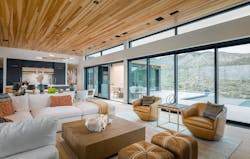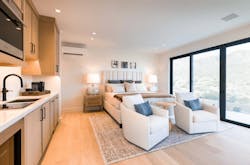People who know the desert will tell you that an oasis can be a mirage, an illusion of a safe haven that, in fact, was never there.
But the Desert Comfort Idea Home, a high-performance, net-zero–energy custom home built in the Sonoran Desert north of Phoenix, the latest in a series of Idea Homes produced by Pro Builder, is very real … and it delivers all of the comforts a desert oasis promises.
The project is the brainchild—and now the personal home—of Mark LaLiberte, a renowned building science expert and co-founder and president of Construction Instruction, a consultancy and training facility based in Denver.
Desert Comfort encompasses a spacious, light-filled 3,000-square-foot main house, a cozy 700-square-foot guest casita, and abundant outdoor living spaces, all built under the direction of Brad Leavitt, owner of A Finer Touch Construction in nearby Scottsdale, Ariz.
Project Specs: Desert Comfort Idea Home
Location: Sonoran Desert, Ariz.
Architects: Peterssen/Keller Architecture, Minneapolis.; Cosan Studio, Scottsdale, Ariz.
Builder: A Finer Touch Construction, Scottsdale
Interior designer: K&Q Interiors, Scottsdale
Size: 3,000 sf (main house); 700 sf (casita)
Beds/baths: 2/2 (main house); 1/1 (casita)
Photos: Alex LaLiberte (exteriors); Paul Moore Studio (interiors)
Innovative Ideas … and a Rough Start
LaLiberte conceived the project to demonstrate a variety of approaches to achieve net zero energy use, building resiliency, and indoor comfort and health in the harsh climate of the desert Southwest.
To do so, he combined and optimized several commercially available materials, products, systems, and practices—including insulated concrete forms (ICFs), structural insulated panels (SIPs), and a “plug-and-play” ducting system—that currently live outside the mainstream of the housing industry.
But while LaLiberte was confident his selective and strategic use of “fringe” market products and practices would deliver the high level of performance he wanted, he and Leavitt were less prepared for the challenges of building during and in the wake of the COVID-19 pandemic.
RELATED
- Net Zero: The Desert Comfort Experience Home Navigates a Perfect Storm
- A Minute With Mark: SIPs Roof Panels [VIDEO]
- Explore the Products Used to Create the Desert Comfort Idea Home
“We couldn’t have picked a worse time to build a house,” LaLiberte says, half-joking that the experience was “19 months of pain and suffering,” including nearly 40 weeks waiting for a building permit, securing materials and products in a timely manner, and finding skilled labor to install unfamiliar technologies.
“There is a very limited labor force, especially when you’re doing something really state-of-the-art,” Leavitt says. “It was difficult to find the right personnel who understood the goals of the project and who were familiar with specific installation practices.”
LaLiberte adds that crews for a project like Desert Comfort must be staffed and trained properly for innovation to pay off. “The first time trying something new will be expensive and time consuming,” he says, and recommends more drawings, details, and training well ahead of the building schedule. “You can’t just assume they’ll figure it out.”
Living in Comfort
Desert Comfort, with its flat roofs, deep overhangs, and neutral-toned stucco exterior, was designed to blend into the Southwestern landscape. Peterssen/Keller Architecture, in Minneapolis, provided initial drawings for the project, while architect Scott Carson of Cosan Studio, in Scottsdale, completed the plans for approvals and construction.
Inside, the earth-toned palette, wood plank ceiling, and seamless form and function designed by Scottsdale’s K&Q Interiors evoke a sense of calm—the perfect environment for LaLiberte, who travels up to 300 days per year, to spend his downtime.
“It’s critical to bring an interior designer to the table early in the process to help guide the overwhelming array of decisions for a custom home project,” he says, then adds, laughing, “If it was just me, I probably would have put a velvet poster of dogs playing poker on the wall and called it good.”
A home automation system allows LaLiberte to manage the home even while he’s on the road. The system controls all of the Desert Comfort's LED lighting, exterior and interior shades, entertainment and security systems, and the indoor climate system. He also can program combinations of lighting, music, shading, and temperature for different occasions. “You can basically control the whole house from your phone,” he says.
Now that LaLiberte has moved in, he is enjoying the results of his and the design/build team’s careful planning and execution. The home is exceptionally quiet and comfortable, he says, and he’s confident it will stay that way as the desert summer kicks into full gear.
RELATED
A Desert Home Built for Resilience
While there's flexibility when it comes to aesthetic choices, which can be changed to some degree, LaLiberte only had one shot at creating a low-load thermal enclosure and managing drainage on the site.
For the former, he specified a combination of an insulated concrete slab with a vapor barrier, R-30 rated perimeter walls using ICFs, an R-55 rated roof system using 8-by-14-foot SIPs, and triple-glazed windows and patio doors—all properly flashed and otherwise sealed to mitigate thermal transfer.
The result is an envelope that is not only tight but that enables extensive use of glass, with deep roof overhangs and proper orientation further reducing heat gain in the summer.
A low-load home also allowed LaLiberte to right-size both heating and cooling to a single, 3.5-ton variable refrigerant flow (VRF) HVAC system, which varies the flow of refrigerant to indoor units based on demand. The system features multiple HVAC zones and an innovative ducting system.
The home’s 8-kilowatt photovoltaic array on the garage roof (see photo below) is a relatively small collection for a combined 3,700 square feet of conditioned space, but it’s mounted using a ballast system that orients the panels to the optimal angle to capture as much sunlight as possible.
The renewable energy system also includes a hybrid inverter that not only allows net metering of surplus electricity with the local utility but also siphons extra power to a 20-kilowatt bank of batteries to keep the lights on when the solar panels aren’t producing as much electricity or during power outages—a truly resilient energy setup.
Meanwhile, siting details and the home’s robust building envelope protect the property from weather in a highly variable climate. An unusually heavy monsoon season tested Desert Comfort’s resiliency last summer, and every detail, from massive footings and tiered retaining walls to the drainage mat on the stem walls, directed water away from the home.
“I think it’s going to be a really durable house in a very complex climate,” LaLiberte says.
Andrew Hunt, VP of Confluence Communications, has worked in the building science industry for more than 20 years with a focus on multimedia production, instructional design, and voice-over narration.










